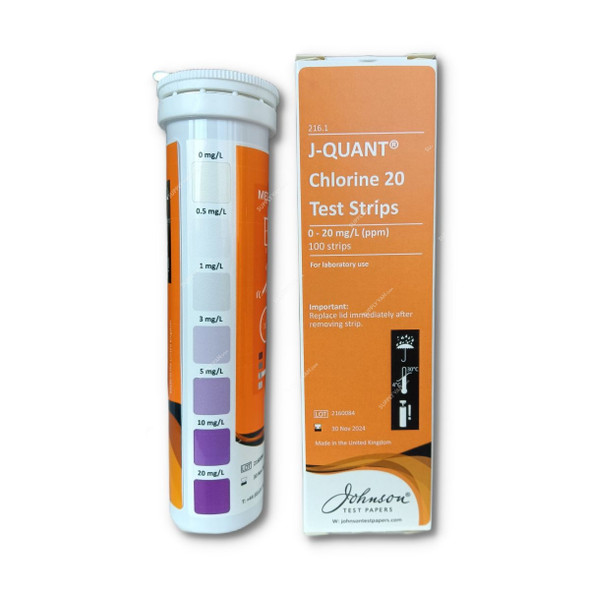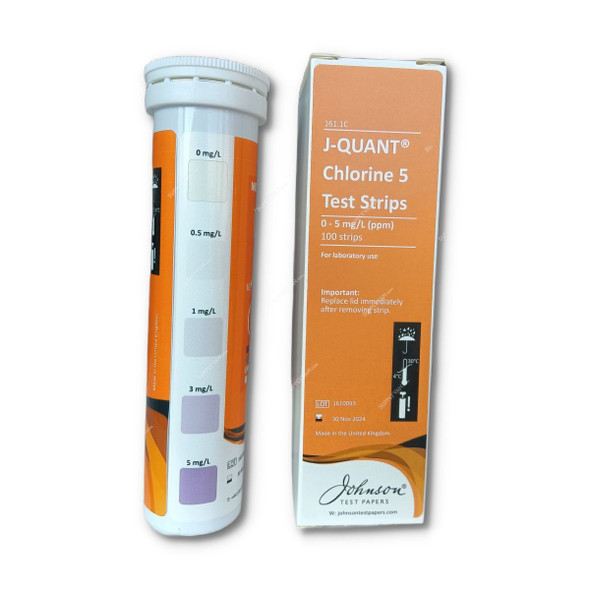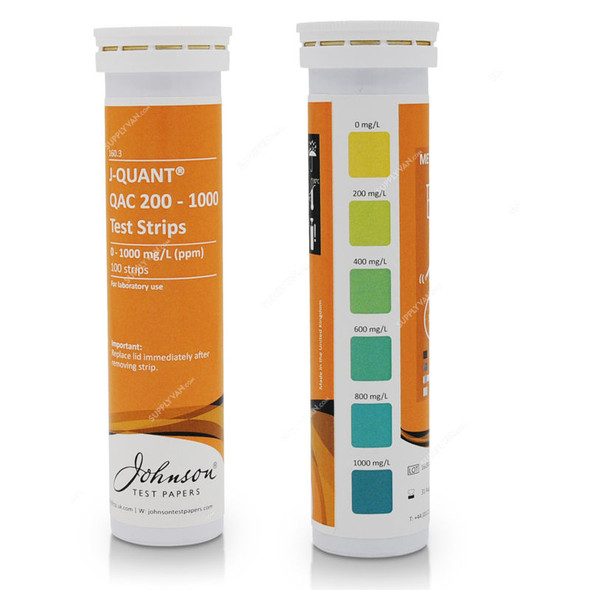Johnson Chlorine Test Strip, 164.1C, J-Quant, 0 to 1000 PPM, 100 Strips/Vial

- Brand:
- Johnson
- SKU:
- 127873461189
- Minimum Purchase:
- 1 unit
- Item Name:
- Chlorine Test Strip
- Model:
- 164-1C
- Product Series:
- J-Quant
- Manufacturer:
- Johnson
- Testing Range:
- 0, 50, 100, 250, 500, 1000 mg/L
- Number of Tests:
- 100
- Direction To Use:
- Immerse the strip in the test sample. Shake the strip to remove the excess if necessary. After the stated wait time has taken place-compare the colour produced on the test strip with the colour on the tube to the determine the concentration
- Packing Type:
- Flip-Top Vial
- Application:
- Laboratory, Healthcare, Food Service, Environmental/Safety, Water Treatment, Industrial
- Brand Origin (not manufacture):
- United Kingdom
- Delivery Time:
- 2-7 Days
- Packing Quantity:
- 1
- Unit:
- Pack
- Pieces per unit:
- 100
Description
Johnson Chlorine Test Strips are used to test the concentration of chlorine in a solution. The strips are formulated to measure a range of 0 to 1000 ppm (parts per million), making them suitable for a variety of applications. The strips are part of the J-Quant line of test strips, which are known for their accuracy and reliability. The test strips come in a vial containing 100 strips, allowing for multiple tests to be performed. To use the test strips, simply dip a strip into the solution you want to test and compare the resulting color to the color chart provided. The color of the strip will change based on the concentration of chlorine in the solution, allowing you to easily determine the chlorine level. The test strips are commonly used in water treatment, swimming pools, and other applications where it is important to monitor chlorine levels.
View AllClose
- Chlorine in solution such as chlorinated disinfectants or sanitizers can be measured easily and rapidly with this basic-reliable and cost effective test
- There are no reagents to mix as everything is on the test strip for the reaction to occur
- Depending on the level being determined-a solid result can be seen in less than one minute
- Water reservoirs-water mains suppliers and swimming pools globally still utilise chlorine based products for disinfection or sanitisation. Electroplaters also utilise chlorine to detoxify cyanide containing waste
- Regulations in some countries may dictate the use of chlorine test strips to ensure the correct concentration of sanitizer solutions are being used as specified by the manufacturer
- Algae production can be avoided-contaminants can be eliminated and toxic microbes can be eradicated if chlorine is at the right level
- Water borne infection can be minimised and safeguards can be put in place to prevent build up from impurities with routine monitoring of chlorine levels
- This level needs to be maintained with routine checks of the amount of chlorine. Too much chlorine can also bad as it can spoil the taste and smell of water. In some cases it can become unsafe for drinking
Item Name: |
Chlorine Test Strip |
Model: |
164-1C |
Product Series: |
J-Quant |
Manufacturer: |
Johnson |
Testing Range: |
0, 50, 100, 250, 500, 1000 mg/L |
Number of Tests: |
100 |
Direction To Use: |
Immerse the strip in the test sample. Shake the strip to remove the excess if necessary. After the stated wait time has taken place-compare the colour produced on the test strip with the colour on the tube to the determine the concentration |
Packing Type: |
Flip-Top Vial |
Application: |
Laboratory, Healthcare, Food Service, Environmental/Safety, Water Treatment, Industrial |
Brand Origin (not manufacture): |
United Kingdom |
Delivery Time: |
2-7 Days |
Packing Quantity: |
1 |
Unit: |
Pack |
Pieces per unit: |
100 |







